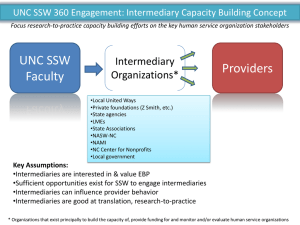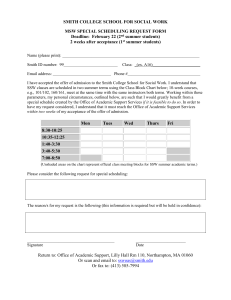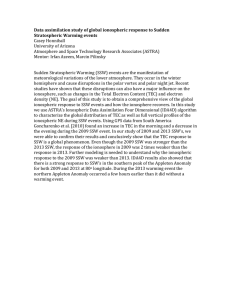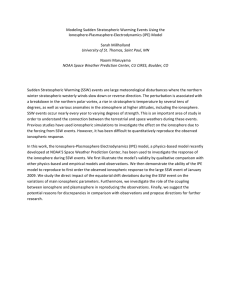Revised BP 2450 Updated:2015-06-12 12:18 CS
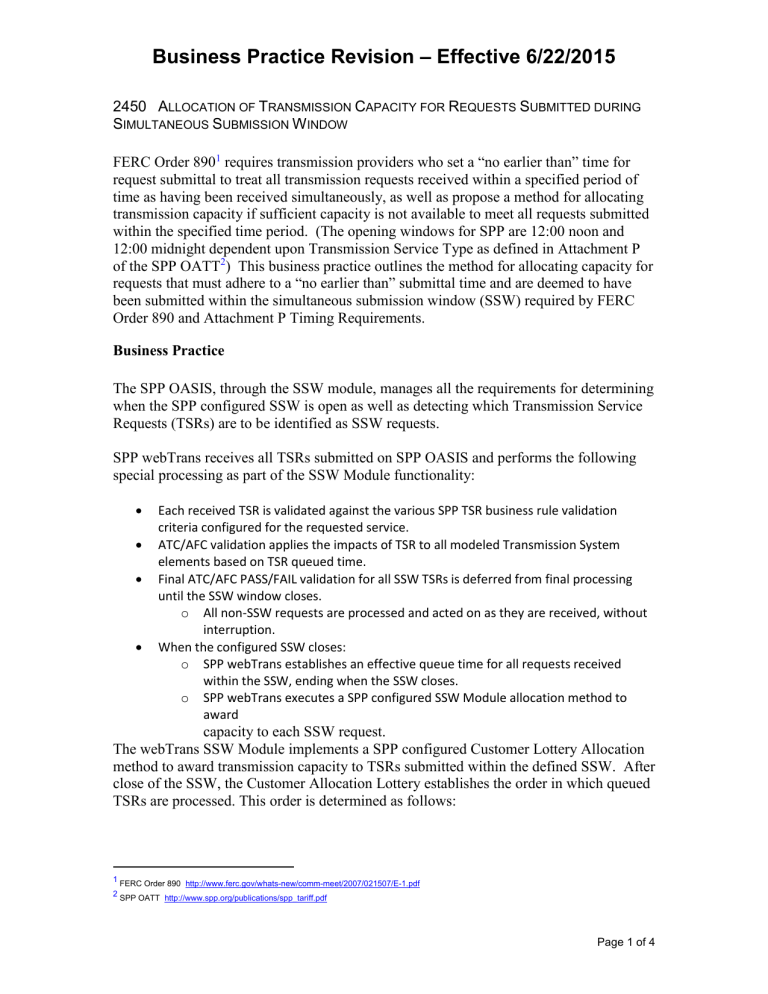
Business Practice Revision
– Effective 6/22/2015
2450 A LLOCATION OF T RANSMISSION C APACITY FOR R EQUESTS S UBMITTED DURING
S IMULTANEOUS S UBMISSION W INDOW
FERC Order 890
1
requires transmission providers who set a “no earlier than” time for request submittal to treat all transmission requests received within a specified period of time as having been received simultaneously, as well as propose a method for allocating transmission capacity if sufficient capacity is not available to meet all requests submitted within the specified time period. (The opening windows for SPP are 12:00 noon and
12:00 midnight dependent upon Transmission Service Type as defined in Attachment P of the SPP OATT
2
) This business practice outlines the method for allocating capacity for requests that must adhere to a “no earlier than” submittal time and are deemed to have been submitted within the simultaneous submission window (SSW) required by FERC
Order 890 and Attachment P Timing Requirements.
Business Practice
The SPP OASIS, through the SSW module, manages all the requirements for determining when the SPP configured SSW is open as well as detecting which Transmission Service
Requests (TSRs) are to be identified as SSW requests.
SPP webTrans receives all TSRs submitted on SPP OASIS and performs the following special processing as part of the SSW Module functionality:
Each received TSR is validated against the various SPP TSR business rule validation criteria configured for the requested service.
ATC/AFC validation applies the impacts of TSR to all modeled Transmission System elements based on TSR queued time.
Final ATC/AFC PASS/FAIL validation for all SSW TSRs is deferred from final processing until the SSW window closes. o All non-SSW requests are processed and acted on as they are received, without interruption.
When the configured SSW closes: o SPP webTrans establishes an effective queue time for all requests received within the SSW, ending when the SSW closes. o SPP webTrans executes a SPP configured SSW Module allocation method to award capacity to each SSW request.
The webTrans SSW Module implements a SPP configured Customer Lottery Allocation method to award transmission capacity to TSRs submitted within the defined SSW. After close of the SSW, the Customer Allocation Lottery establishes the order in which queued
TSRs are processed. This order is determined as follows:
1
FERC Order 890 http://www.ferc.gov/whats-new/comm-meet/2007/021507/E-1.pdf
2
SPP OATT http://www.spp.org/publications/spp_tariff.pdf
Page 1 of 4
Business Practice Revision
– Effective 6/22/2015
Sort all requests submitted within the SSW into different priority tiers in the following priority order: o Request NERC Curtailment Priority o Request Duration o Request Pre-Confirmation Status
For each set of requests that go through the above three criteria and arrive at the same priority: o Assign a customer selection order at random from the set of distinct customers that have submitted TSRs within that priority tier o Each of those customers gets a round-robin lottery queue position assigned to each of their submitted TSRs o Once all TSRs in the SSW have been assigned a lottery evaluation order, webTrans will complete the final ATC/AFC validation for each TSR in lottery order
The SSW Module Allocation Lottery process establishes the relative order for evaluation of SSW TSRs within the overall queue of pending requests being processed within webTrans. The actions taken on those TSRs, including offer of partial service, initiation of the Preemption and Competition process, etc., are handled identically to the evaluation of any non-SSW request in pending queue order.
Requests accepted in accordance with this Business practice remain subject to displacement due to the scheduling of Firm service and/or the submittal of a request of higher priority and/or longer duration.
SSW processing Example:
Sample TSR queue at close of SSW window:
Page 2 of 4
Business Practice Revision
– Effective 6/22/2015
Initial TSR Queue
Customer Request # - NERC Priority - Duration (hours)
Customer
B
D
A
C
C
A
B
NERC
Priority
2
6
2
6
6
6
6
Duration 1 2 3 4 5 6 7 8 9 10 11 12 13 14 15 16 17 18 19 20 21 22 23 24
16
12
24
6
2
24
24
C1 - 6 - 6
B2 - 2 - 16
B3 - 6 - 12
A1 - 6 - 24
B1 - 6 - 24
A2 - 2 - 24
C2 6 2
A
C
B
2
2
6
16
24
24
C3 - 2 - 24
B3 - 6 - 24
A3 -2 - 16
A 2 2 A4 2 2
At close of SSW window, module established “buckets” of requests of same NERC priority, duration and pre-confirmation status.
Bucket Allocation
Bucket #1
A1 - 6 - 24
B1 - 6 - 24
B3 - 6 - 24
Bucket #2
B4 - 6 - 12
Bucket #3
C1 - 6 - 6
Bucket #4
C2 6 2
Bucket #5
A2 - 2 - 24
C3 - 2 - 24
Bucket #6
B2 - 2 - 16
A3 -2 - 16
Bucket #7
A4 2 2
SSW “Bucket” processing sequence:
SSW module identifies 3 customers: customer A, B, and C (any/all buckets)
Customer Lottery process identifies a random "Customer Order"
Initial submission Customer Queue order was A - B - C
Page 3 of 4
A1 - 6 - 24
B1 - 6 - 24
B3 - 6 - 24
B4 - 6 - 12
Business Practice Revision
– Effective 6/22/2015
Ex: Lottery process for this window established the order of B - A - C
Requests within a bucket will be processed in Lottery order, with
one request per customer at a time.
TSR AFC/ATC Allocation Sequence
Bucket #1 (Three requests)
First request processed will be the first request entered by Customer B
Second request processed will be the first request entered by Customer A
Third request processed would be the first request entered by Customer C
If no Customer C requests exist, process starts over with Customer B
1st
2nd
3rd
Bucket #2 (One request)
B1 - 6 - 24
A1 - 6 - 24
B3 - 6 - 24
B4 - 6 - 12
Bucket #3 ( one request)
C1 - 6 - 6
Bucket #4 (One request)
Bucket #5 (Two requests - None from customer B)
A2 - 2 - 24
C3 - 2 - 24
Bucket #6 (Two requests)
1st
2nd
B2 - 2 - 16
A3 -2 - 16
C2 6 2
Bucket #7 (One request)
A4 2 2
The above defined procedure is applied only to those requests entering the queue during the defined Simultaneous Submission Window.
Page 4 of 4
